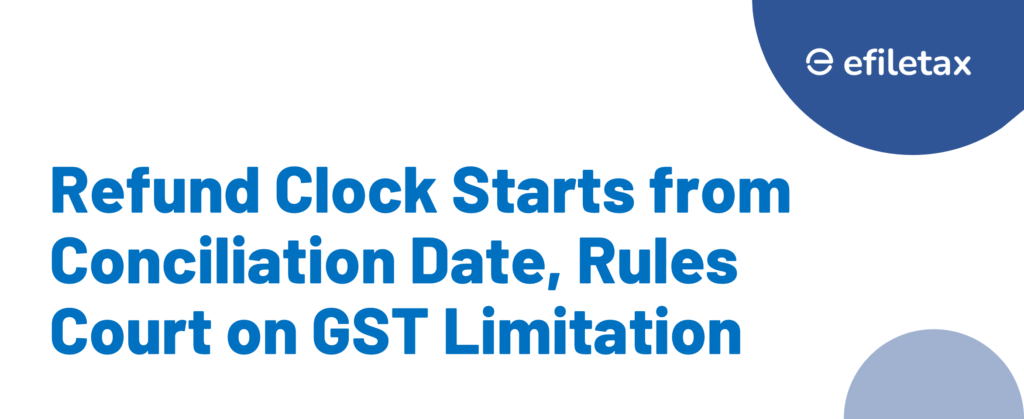
Refund Limitation Period Starts from Conciliation Agreement Date
Under GST, claiming a refund is time-sensitive. The Delhi High Court has clarified that the refund limitation period begins only when the excess tax quantum is crystallised, not from the original payment date.
This is a significant relief for businesses resolving disputes through conciliation. Let’s break it down.
What the Delhi High Court Held
In Wipro Limited v. Union of India & Ors. [2024], the Delhi High Court held that:
- The two-year limitation under Section 54(1) of the CGST Act, 2017 should be computed from the date when the amount of excess tax becomes determinable, i.e., the date of the conciliation agreement, not the original payment date.
- The court interpreted “relevant date” in a way that aligns with the spirit of natural justice and avoids penalising the assessee for delays beyond their control.
Legal Provisions Involved
| Provision | Description |
|---|---|
| Section 54(1), CGST Act | Refund application to be filed within 2 years from the relevant date. |
| Explanation (2)(e) to Section 54 | For other cases, relevant date = date of payment. |
| Conciliation Agreement | Under Arbitration and Conciliation Act, 1996, a conciliation agreement is binding and final once signed. |
Practical Implications
This judgment provides relief in cases where:
- Dispute resolution takes time – refund eligibility isn’t lost due to procedural delays.
Who benefits?
- Exporters in litigation
- Contractors in infrastructure disputes
- Businesses with tax overpayments under reconciliation
Expert Tip: Don’t Delay Post-Conciliation
Courts may accept delayed filing only up to the point of quantification. Post that, you’re bound by the 2-year limit.
Keyphrase in Action: Refund Limitation Period
When does the refund limitation period begin?
- If refund arises after conciliation, limitation is from agreement date, not original payment.
- This overrides the generic rule in Section 54 Explanation 2(e).
Example:
- Tax paid in Feb 2021
- Conciliation completed in Nov 2023
- Refund application deadline: Nov 2025
Comparison: Generic vs. Conciliation-Based Refunds
| Parameter | Generic Refund | Post-Conciliation Refund |
|---|---|---|
| Trigger Date | Date of tax payment | Date of conciliation agreement |
| Limitation Ends | After 2 years from tax date | After 2 years from agreement date |
| Legal Support | Sec 54 + Explanation (2)(e) | Delhi HC judgment in Wipro case |
FAQs
Q1. Can I rely on conciliation to get refund beyond 2 years from payment date?
Yes, if the excess tax was determinable only after conciliation. File within 2 years from agreement date.
Q2. What if there’s no conciliation, only emails or verbal assurances?
Refund clock still ticks from payment date unless there’s a formal binding document quantifying excess tax.
Q3. Is this judgment applicable across India?
Yes, unless contradicted by another High Court or Supreme Court. It’s a strong persuasive precedent under GST.
Final Thoughts
The Delhi HC’s interpretation of refund limitation period aligns with fairness in tax administration. When excess tax arises from reconciliatory settlements, the taxpayer shouldn’t be penalised for procedural timelines.
If you’ve overpaid GST and settled through conciliation, act quickly. The 2-year countdown starts from the day of quantification — not earlier.
CTA
Need help filing your GST refund after a conciliation or dispute resolution?
Let Efiletax handle your timelines, documentation, and compliance — accurately and legally.
External References
Related Reads from Efiletax
Summary
The Delhi High Court ruled that the GST refund limitation period starts from the date of a conciliation agreement that quantifies excess tax. Taxpayers now get two years from that date to file, offering relief in post-dispute resolutions.